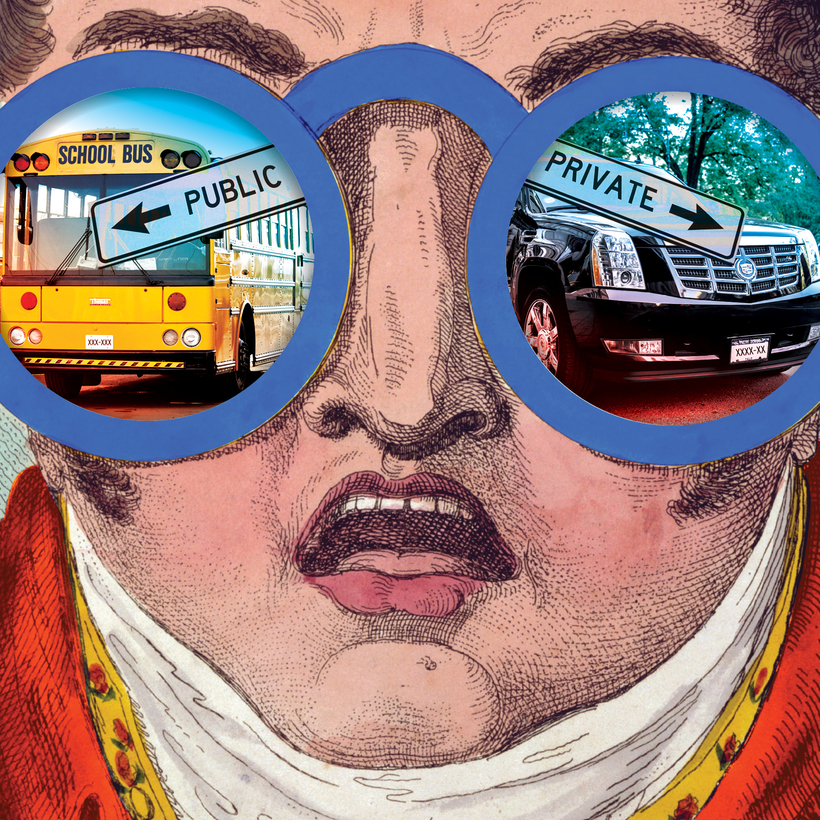Next to Brearley, Dalton, and Harvard-Westlake, P.S. 108 is looking pretty good, don’t you think?
The most elite and expensive private schools around the country are embattled—and near hysteria—over issues of race, anti-racism, and the woke curriculum, while urban public schools are just trying to reopen with better protections against the coronavirus.
So here’s an idea. Instead of subjecting students, teachers, and parents paying $50,000 a year in tuition to seminars on D.E.I. (Diversity, Equity, and Inclusion) or C.R.T. (Critical Race Theory), to learn “restorative practices,” and to subcontract pricey consultants to teach them about white privilege, systemic racism, and “spirit murder,” why not just send the children to public school?
It doesn’t have to be forever—though in March, in The Atlantic, Caitlin Flanagan made a pretty compelling case for abolishing all private schools. But until then, maybe instead of a study-abroad program in France, Italy, or Peru, 11th-graders should sign up for a semester of total immersion in normal life.
This low-cost alternative offers kids from underfunded school districts a chance to study Chekhov and chamber music at Collegiate, conduct experiments in Stanford-worthy chemistry labs, and receive one-on-one computer-coding lessons. Most public schools offer race and ethnic studies—for free. Girls from Nightingale-Bamford would also learn a) how to take public transportation, and b) how to study trigonometry with a teacher who doesn’t know or care who their parents are.
Maybe instead of a study-abroad program in France, Italy, or Peru, 11th-graders should sign up for a semester of total immersion in normal life.
It’s certainly a more practical way to expose overly sheltered children to reality than urging them not to refer to their parents as “Mom” and “Dad.” (According to Grace Church School’s 12-page Inclusive Language Guide, those terms can be insensitive to people without one or the other; the preferred phrasing is “folks” or “grown-ups.”)
There is hyperbole and extremism on both sides, be it from the C.R.T. true believers or those wealthy parents who want schools to focus on the S.A.T.’s. And French, Latin, and Mandarin. This week, the backlash hit the Catholic girls’ school Marymount, which incensed some parents by sending invitations to a reception for parents that included only those of “new students of color.” Actually, this does seem like rank injustice: Why should white parents be exempted from having to attend an insufferable after-work school function?
What all the fuss and finger-pointing reveals, however, is that neither side seems to have any faith in the resilience of the people whose instruction they are fighting over, namely the students.
The “anti-racist” curriculum seems designed to turn the classroom at, say, Dalton into a social version of an anti-gravity simulator at NASA—without actually allowing the subjects to experience the side effects, even thirdhand. Student sensibilities are considered so fragile that after an irate father of a Brearley sixth-grader, Andrew Gutmann, wrote a long, fulminating denunciation of the school’s Red Guard conformity, Brearley’s head of school, Jane Fried, responded by saying that Mr. Gutmann had “frightened” her pupils. Or, as she put it in a letter of her own, “they felt frightened and intimidated by the letter and the fact that it was sent directly to their homes.”
If Brearley girls can’t handle the indignant splutters of an alpha former investment banker—in writing—how will they ever learn to actually work at a bank? Or bank at a bank? (Also, when did concision get tossed from the curriculum? If teachers and parents really want to mold young minds, they would set an example by expressing themselves in 900 words or less.)
Private-school parents and teachers who are appalled by the Ibram X. Kendi–fication of social studies and English classes share the same mistrust: they are so over-involved in their children’s schooling that they personalize every lesson; rather than trusting their children to distinguish between rhetoric and reality, they paint the anti-racist curriculum as demonizing white kids, as one math teacher at Grace Church, who was suspended for his apostasy, put it in a lengthy manifesto.
Neither side seems to have any faith in the resilience of the people whose instruction they are fighting over, namely the students.
Private schools used to be called “prep schools” because they prepared students for college and real life; instead they are cocooning them well into their late teens. My former New York Times colleague Donald McNeil, the lead science reporter covering the coronavirus, was forced to leave the paper in February because seniors on a $6,000 trip to Peru in 2019 complained to their parents about Donald’s un-woke attitude, saying he had used the n-word in a discussion about the use of the n-word.
Here’s the shocking part: those college-bound kids are so infantilized that, rather than shrug it off or lodge a complaint on their own, they went to their parents for redress, and the parents actually agreed to fight their battles: a bunch complained to Donald’s bosses, and, sadly, they were heeded. Lesson learned: The New York Times is turning into Dalton for adults.
So what’s the solution? Parents, teachers, students, and newspaper editors should spend a semester in public school, maybe the one place left where parents are kept in their place.
Alessandra Stanley is a Co-Editor of AIR MAIL


